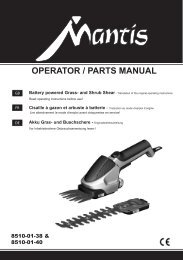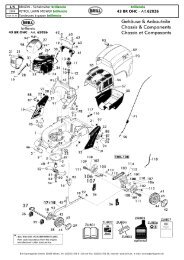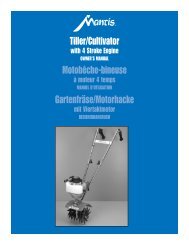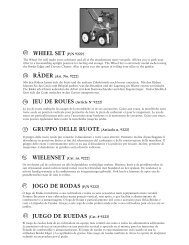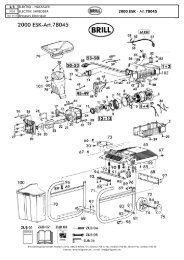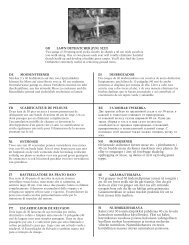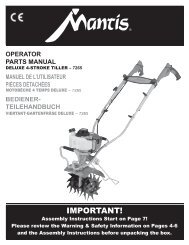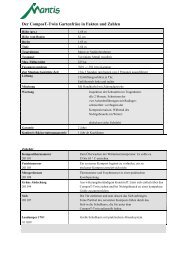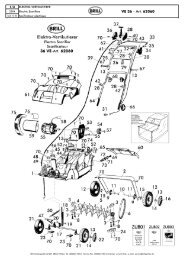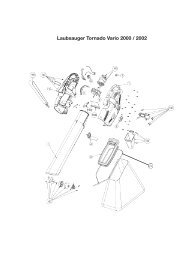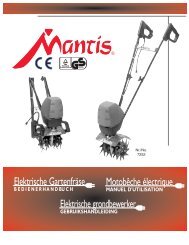You also want an ePaper? Increase the reach of your titles
YUMPU automatically turns print PDFs into web optimized ePapers that Google loves.
<strong>Tiller</strong>/<strong>Cultivator</strong><br />
with Honda Engine<br />
OWNER’S MANUAL<br />
Motobêche-bineuse<br />
avec moteur Honda<br />
MANUEL D'UTILISATION<br />
Gartenfräse/Motorhacke<br />
mit Honda-Motor<br />
BEDIENERHANDBUCH
Welcome to the world of<br />
<strong>Mantis</strong> gardening<br />
Here’s your new MANTIS <strong>Tiller</strong> . . .<br />
the lightweight wonder that’s changing<br />
the way we garden.<br />
Unlike big tillers, your MANTIS <strong>Tiller</strong><br />
weighs only 24 pounds (11 kg). So it<br />
lifts easily, handles smoothly, tills and<br />
weeds precisely. And, unlike other<br />
small tillers, it features serpentine tines<br />
that churn soil to 25 cm deep. It creates<br />
a soft, smooth seed bed, even in<br />
problem soil.<br />
Once you know how to use your tiller<br />
correctly, we guarantee you’ll love it.<br />
So first, please read this manual. It<br />
shows, step by step, how to use your<br />
tiller safely. Plus, it shows how the<br />
MANTIS Border Edger can make light<br />
work of your edging needs.<br />
If you have questions about any topic<br />
in this Manual or if you wish to order<br />
MANTIS attachments, contact your<br />
local authorised <strong>Mantis</strong> office.<br />
Table of contents<br />
Safety rules & warnings . . . . . . . . . . . . . . . . . . .3-5<br />
Safety labels . . . . . . . . . . . . . . . . . . . . . . . . . . . . .4<br />
Engine & fuel warnings . . . . . . . . . . . . . . . . . . . .5<br />
Assembly and mixing fuel . . . . . . . . . . . . . . . .6-9<br />
Starting . . . . . . . . . . . . . . . . . . . . . . . . . . . . .10-11<br />
Additional information . . . . . . . . . . . . . . . . . . . .11<br />
Getting to your garden . . . . . . . . . . . . . . . . . . . .11<br />
Tilling & cultivating . . . . . . . . . . . . . . . . . . .12-13<br />
Tine positioning. . . . . . . . . . . . . . . . . . . . . . . . . 3<br />
Storage . . . . . . . . . . . . . . . . . . . . . . . . . . . . . . . .15<br />
MANTIS <strong>Tiller</strong> assembly layout . . . . . . . . . . . .16<br />
Parts assemblies . . . . . . . . . . . . . . . . . . . . . . . . .17<br />
Troubleshooting . . . . . . . . . . . . . . . . . . . . . . . . .18<br />
The <strong>Mantis</strong> Promise . . . . . . . . . . . . . . . . . . . . . .19<br />
2
Safety rules & warnings<br />
You will notice throughout this owners manual safety rules and important notes. Make sure you understand<br />
and obey these warnings for your own protection.<br />
I. Special safety information<br />
! WARNING • DANGER !<br />
ATTENTION: THIS SYMBOL POINTS OUT<br />
OUR IMPORTANT SAFETY INSTRUCTIONS.<br />
WHEN YOU SEE THIS SYMBOL,<br />
HEED IT’S WARNING!! STAY ALERT!!<br />
!<br />
! WARNING • DANGER !<br />
TO REDUCE THE POTENTIAL FOR ACCIDENTS, COMPLY WITH<br />
THE SAFETY INSTRUCTIONS IN THIS MANUAL.<br />
FAILURE TO COMPLY MAY RESULT IN SERIOUS PERSONAL<br />
INJURY, AND/OR EQUIPMENT AND PROPERTY DAMAGE.<br />
II. Safety & warnings<br />
! WARNING • DANGER !<br />
IMPROPER USE OR CARE OF THIS TILLER<br />
OR FAILURE TO WEAR PROPER PROTECTION<br />
CAN RESULT IN SERIOUS INJURY.<br />
READ AND UNDERSTAND THE RULES FOR SAFE OPERATION<br />
AND ALL INSTRUCTIONS IN THIS MANUAL.<br />
WEAR HEARING AND EYE PROTECTION.<br />
3
III. Safety label information<br />
An important part of the safety system incorporated in this tiller<br />
are the warning and information labels found on various parts of the<br />
tiller. These labels must be replaced in time due to abrasion, etc. It is your<br />
responsibility to replace these labels when they become hard to read. The<br />
location and part numbers (P/N) of these labels are illustrated on Page 27.<br />
P/N 400620<br />
CUTTING HAZARD; KEEP<br />
FEET AND HANDS AWAY<br />
FROM ROTATING TINES.<br />
DO NOT CARRY THE TILLER<br />
IN THIS POSITION.<br />
READ OWNER’S MANUAL<br />
BEFORE USING TILLER, OR<br />
PERFORMING ANY REPAIR<br />
OR MAINTENANCE. KEEP<br />
OWNERS MANUAL IN A<br />
SAFE PLACE.<br />
DON’T FUEL, REFUEL, OR<br />
CHECK FUEL WHILE<br />
SMOKING, OR NEAR AN<br />
OPEN FLAME OR OTHER<br />
IGNITION SOURCE.<br />
P/N 400609<br />
CAUTION: WHEN<br />
ASSEMBLING THE HANDLES,<br />
MAKE SURE FUEL TANK FACES<br />
AWAY FROM OPERATOR. THIS<br />
IS THE REAR OF THE TILLER,<br />
REFER TO ASSEMBLY<br />
INSTRUCTION ON PAGE 7.<br />
INCORRECT ASSEMBLY.<br />
WEAR EAR AND EYE<br />
PROTECTION.<br />
! WARNING • DANGER !<br />
IF THE TILLER IS USED IMPROPERLY OR SAFETY PRECAUTIONS ARE NOT FOLLOWED,<br />
THE USERS RISK SERIOUS INJURY TO THEMSELVES AND OTHERS.<br />
READ AND UNDERSTAND THIS MANUAL BEFORE ATTEMPTING TO OPERATE THIS TILLER.<br />
IV. Warnings - do’s<br />
Read and understand the owner’s<br />
manual. Pay particular attention to all<br />
sections regarding safety.<br />
1. Always keep a firm grip on both<br />
handles while the tines are moving and/or<br />
the engine is running. BE AWARE!! The<br />
tines may coast after throttle trigger is<br />
released. Make sure tines have come to a<br />
complete stop and engine is off before<br />
letting go of the tiller.<br />
2. Always maintain a firm footing and<br />
good balance. Do not overreach while<br />
operating the tiller. Before you start to use<br />
the tiller, check the work area for obstacles<br />
that might cause you to lose your footing,<br />
balance or control of the machine.<br />
3. Thoroughly inspect the area where<br />
equipment is to be used and remove all<br />
objects, which can be thrown by the<br />
machine.<br />
4. Always keep area clear of children,<br />
pets, and bystanders.<br />
5. Always stay alert. Watch what you<br />
are doing and use common sense. Do not<br />
4<br />
operate unit when fatigued.<br />
6. Always dress properly. Do not wear<br />
loose clothing or jewellery, they might get<br />
caught in moving parts. Use sturdy gloves.<br />
Gloves reduce the transmission of<br />
vibration to your hands. Prolonged<br />
exposure to vibration can cause numbness<br />
and other ailments.<br />
7. While working, always wear<br />
substantial footwear and long trousers. Do<br />
not operate the equipment when barefoot<br />
or wearing open sandals.<br />
8. Always wear ear and eye protection.<br />
Eye protection must meet applicable CE<br />
requirements. To avoid hearing damage,<br />
we recommend hearing protection be<br />
worn whenever using the equipment.<br />
9. To reduce fire hazard, keep the<br />
engine, and petrol/fuel storage area free of<br />
vegetative material and excessive grease.<br />
10. Start the engine carefully,<br />
according to the manufacturer’s<br />
instructions and with feet well away from<br />
tool(s).<br />
11. Keep all nuts, bolts and screws<br />
tight to be sure the equipment is in safe<br />
working condition.<br />
12. Use extreme caution when<br />
reversing or pulling the machine towards<br />
you.<br />
13. Work only in daylight or good<br />
artificial light.<br />
14. Always be sure of your footing on<br />
slopes.<br />
15. Exercise extreme caution when<br />
changing direction on slopes.<br />
16. Always keep a safe distance<br />
between two or more people when<br />
working together.<br />
17. Always inspect your unit before<br />
each use and ensure that all handles,<br />
guards and fasteners are secure, operating,<br />
and in place.<br />
18. Always maintain and examine your<br />
<strong>Tiller</strong> with care. Follow maintenance<br />
instructions given in manual.<br />
19. Always store tiller in a sheltered<br />
area (a dry place), not accessible to<br />
children. The tiller as well as fuel should<br />
not be stored in a house.
V. Warnings - don'ts<br />
Don’t use tiller with one hand.<br />
Keep both hands on handles with<br />
fingers and thumbs encircling the<br />
handles, while tines are moving,<br />
and engine is running.<br />
Don’t overreach. Keep a good<br />
footing at all times.<br />
Don’t run with the machine,<br />
walk.<br />
Don’t work on excessively<br />
steep slopes.<br />
Don’t attempt to clear tines<br />
while they are moving. Never try<br />
to remove jammed material before<br />
switching the engine off and<br />
making sure the tines have<br />
stopped completely.<br />
Don’t allow children or<br />
incapable people to operate this<br />
tiller.<br />
Don’t operate while under<br />
the influence of alcohol or drugs.<br />
Don’t attempt to repair this<br />
tiller. Have repairs made by a<br />
qualified dealer or repairman. See<br />
that only original <strong>Mantis</strong> parts are<br />
used.<br />
! WARNING • DANGER !<br />
HANDLE FUEL WITH CARE, IT IS HIGHLY FLAMMABLE. FUELLING A HOT ENGINE OR NEAR AN IGNITION<br />
SOURCE CAN CAUSE A FIRE AND RESULT IN SERIOUS PERSONAL INJURY AND/OR PROPERTY DAMAGE.<br />
VI. Engine/fuel warnings - do’s<br />
Always use fresh petrol. Stale<br />
petrol can cause damage.<br />
Always store fuel in containers<br />
specifically designed for this<br />
purpose.<br />
Always pull starter cord slowly<br />
until resistance is felt. Then pull cord<br />
rapidly to avoid kickback and<br />
prevent arm or hand injury.<br />
Always operate engine with spark<br />
arrestor installed and operating<br />
properly.<br />
Stop the engine whenever you<br />
leave the machine.<br />
Allow the engine to cool before<br />
storing in any enclosure.<br />
If the fuel tank needs to be<br />
drained, this should be done<br />
outdoors.<br />
VII. Engine/fuel warnings - don’ts<br />
Don’t fuel, refuel or check fuel<br />
while smoking, or near an open<br />
flame or other ignition source. Stop<br />
engine and be sure it is cool before<br />
refuelling.<br />
Don’t leave the engine running<br />
while the tiller is unattended. Stop<br />
engine before putting the tiller<br />
down or while transporting from<br />
one place to another.<br />
Don’t refuel, start or run this<br />
tiller indoors or in an improperly<br />
ventilated area.<br />
Don’t run engine when electrical<br />
system causes spark outside the<br />
cylinder. During periodical checks<br />
of the spark plug, keep plug a safe<br />
distance from cylinder to avoid<br />
burning of evaporated fuel from<br />
cylinder.<br />
Don’t check for spark with<br />
spark plug or plug wire removed.<br />
Use an approved tester.<br />
Don’t crank engine with spark<br />
plug removed unless spark plug<br />
wire is disconnected. Sparks can<br />
ignite fumes.<br />
Don’t run engine when the<br />
odour of petrol is present or other<br />
conditions exist.<br />
Don’t operate the unit if petrol<br />
is spilled. Clean up spill completely<br />
before starting engine.<br />
Don’t operate your tiller if there<br />
is an accumulation of debris around<br />
the exhaust, and cooling fins.<br />
Don’t touch the hot exhaust,<br />
cylinders or cooling fins as<br />
contact may cause serious burns.<br />
Don’t change the engine<br />
governor setting or over speed the<br />
engine.<br />
5
Assembly<br />
! WARNING•DANGER !<br />
IMPROPER ASSEMBLY OF THIS TILLER<br />
CAN RESULT IN SERIOUS INJURY.<br />
MAKE SURE TO FOLLOW ALL<br />
INSTRUCTIONS CAREFULLY.<br />
IF YOU HAVE ANY QUESTIONS<br />
CONTACT, YOUR LOCAL AUTHORISED<br />
MANTIS OFFICE.<br />
40 39<br />
20,21,55<br />
1<br />
2<br />
8<br />
53<br />
42<br />
6<br />
Your MANTIS <strong>Tiller</strong> comes partially<br />
assembled. You must install only the<br />
handlebars, the carrying handle, and the<br />
tines. This will take just a few minutes if<br />
you follow the directions.<br />
First, take all items out of the<br />
carton. But do not remove the cardboard<br />
from around the tiller’s base.<br />
The list at the right, shows the parts that<br />
come with your tiller. Check to make sure<br />
you have them.<br />
The bag of hardware is in the plastic bag<br />
containing the Owner’s Manual and Video.<br />
To assemble your MANTIS <strong>Tiller</strong>,<br />
you’ll need two 7/16" (11 mm)<br />
spanners/wrenches. We suggest that you<br />
install all nuts and bolts only “finger tight”<br />
— that is, one-half to one full turn —<br />
until you’ve completed assembly. The<br />
nuts are self locking, but you must use<br />
a spanner/wrench to tighten them<br />
completely.<br />
Quantity Description *Key No.<br />
1 Upper handle assembly 2<br />
1 Upper handle throttle side assembly 1<br />
2 Lower handles 6<br />
1 Pair tiller/cultivator tines 39,40<br />
1 Engine assembly (includes fender<br />
guard & worm tear transmission) 20,21,55<br />
1 Handle brace 8<br />
1 Plastic carrying handle 42<br />
1 Bag of hardware containing:<br />
2 Cap screws 47<br />
4 Lock nuts 48<br />
2 Bolts 3” (7.62 cm) 49<br />
2 Tine retaining pins 41<br />
2 Handle clamps 51<br />
1 Throttle clips 13<br />
2 Bolts 52<br />
2 Knobs 53<br />
*These numbers are the same numbers shown on the parts<br />
layout on page 18.<br />
6
Assembly (continued)<br />
HOW TO ASSEMBLE<br />
LOWER HANDLES<br />
To identify part numbers, see<br />
pages 6 and 18.<br />
1. Use the protective cardboard<br />
sleeve to stabilise your tiller. Stand<br />
the engine assembly (no. 21) up.<br />
(Picture 1)<br />
2. Lay the handle parts within<br />
easy reach. You’ll need one of the<br />
handle clamps (no. 51) and one of<br />
the lower handles (no. 6). Note that<br />
the lower handles have a short leg<br />
on one end.<br />
3. Fit the handle clamp along the<br />
outside of the short leg. Line up the<br />
holes on the clamp and the leg.<br />
4. Choose one of the two 3-inch<br />
(7.62 cm) bolts (no. 49). Slide it<br />
through the first set of holes — near<br />
the elbow where the lower handle<br />
curves. (Picture 2 & 3)<br />
5. Now slide the other lower<br />
handle onto the 3-inch<br />
(7.62 cm) bolt. Fit the other<br />
clamp onto this other handle’s<br />
short leg. Add a nut and tighten<br />
finger tight. (Picture 3)<br />
6. Locate the worm gear<br />
housing. It starts just above —<br />
and extends down through —<br />
the tiller’s red fender guard.<br />
You’ll notice that there’s a<br />
recessed channel on either side of<br />
the housing’s top. (Picture 4.)<br />
7. Take the lower handles that<br />
you’ve just put together. Slide them<br />
into the two recessed<br />
channels.(Picture 5.)<br />
Make sure you insert them<br />
from the rear of the tiller . . . so that<br />
the bolt fits along the back of the<br />
housing.<br />
8. Slide the second 3-inch<br />
(7.62 cm) bolt through the second<br />
set of holes in the short legs. Add a<br />
nut and tighten finger tight.<br />
Picture 1<br />
NOTE: THE LOCK NUTS ARE STAMPED. FINGER TIGHT IS<br />
APPROXIMATELY 1/2 TO 1-1/2 TURNS.<br />
Picture 2<br />
Picture 3 Picture 4 Picture 5<br />
7
Assembly (continued)<br />
How to assemble upper<br />
handles and carrying<br />
handle<br />
1. Lightly squeeze the lower<br />
handles (no. 6) toward one<br />
another so that they line up with<br />
the two smaller holes on the<br />
carrying handle (no. 42). Then<br />
slide the carrying handle over and<br />
down the lower handles. It will<br />
rest about 10 to 15 cm above the<br />
fender. (Picture 1)<br />
2. Gently pull the lower<br />
handles out to their original<br />
position.<br />
3. Attach the upper handle<br />
assembly (no. 1) – the handle with<br />
the throttle cable and ground wire<br />
– onto the right lower handle, and<br />
secure with the handle knob (no.<br />
53). (Picture 2 and 3)<br />
Note: If throttle handle is<br />
mounted on the left, it will not<br />
fold down as completely as when<br />
mounted on the right.) Be sure<br />
you have proper throttle<br />
movements and that the throttle<br />
cable is not wrapped or twisted<br />
around the handle bar. Squeeze<br />
trigger and let go.<br />
THIS MUST BE DONE<br />
BEFORE STARTING THE<br />
ENGINE.<br />
4. Follow the same steps to<br />
install the other upper handle<br />
onto the other lower handle.<br />
(Picture 3)<br />
5. Use the clip (no. 13) to<br />
secure the throttle cable and wire<br />
in place on the lower handle.<br />
(Picture 4)<br />
6. Now install the handle<br />
brace. Line it up with the holes<br />
on the upper handles. Then insert<br />
a cap screw and a lock nut on<br />
either side (Picture 5)<br />
7. Use a spanner/wrench to<br />
tighten cap screws and lock nuts.<br />
8. Now use spanner/wrench to<br />
tighten all nuts and bolts firmly<br />
and securely.<br />
IMPORTANT NOTE:<br />
Make sure you have installed<br />
the handles properly. When<br />
you stand behind your tiller,<br />
holding the handles, the fuel<br />
tank is facing away from you,<br />
on the front side of the engine.<br />
!<br />
WARNING: Improper throttle installation can cause<br />
tines to rotate unexpectedly .<br />
Picture 1<br />
! WARNING • DANGER !<br />
REMOVE TINES BEFORE STARTING ENGINE<br />
AND MAKING ADJUSTMENTS.<br />
Picture 2<br />
8<br />
Picture 3<br />
Picture 4 Picture 5
Assembly (continued)<br />
Assembling the tines<br />
for tilling<br />
1. Remove the cardboard from<br />
around your tiller’s base.<br />
2. Slide the tines onto the axle<br />
shafts. The “D” hole goes on the<br />
outside.<br />
3. Make sure you’ve installed<br />
the tines properly for tilling.<br />
Liken the tines to your fingers.<br />
When your palm faces the<br />
ground, your fingers curl down.<br />
Stand behind the tiller and hold<br />
your hand next to the tines. Do<br />
the tine blades curl down, as your<br />
fingers do? If so, they are in the<br />
tilling position. (To switch to the<br />
cultivating position, see page 12.)<br />
4. To secure each tine to the<br />
axle, insert a tine retaining pin.<br />
IMPORTANT NOTE:<br />
Before starting your<br />
Honda/<strong>Mantis</strong> <strong>Tiller</strong>, add the<br />
premeasured 3.4 oz. (100 ml)<br />
bottle of Honda 4 -stroke<br />
engine oil. See Honda engine<br />
manual for details.<br />
IMPORTANT NOTE:<br />
Check the oil level in the engine before each use. Place the<br />
tiller on a level surface and rotate it forward until it rests on<br />
it’s fuel tank. Remove the oil fill cap and make sure the oil is to<br />
the top (about to overflow). If oil is low, top it off with 10W-30<br />
before using. See your Honda engine manual for details.<br />
IMPORTANT NOTE:<br />
Before you use your<br />
MANTIS <strong>Tiller</strong>, read the<br />
safety rules & warnings<br />
on pages 3-5.<br />
! WARNING • DANGER !<br />
FUEL IS EXTREMELY FLAMMABLE. HANDLE IT WITH<br />
CARE. KEEP AWAY FROM IGNITION SOURCES. DO NOT<br />
SMOKE WHILE FUELLING YOUR EQUIPMENT.<br />
Never use starting fluids as they will cause permanent engine damage. Using them will void the warranty.<br />
Before you use the tiller, read the safety & warning rules on pages 3-6.<br />
9
Starting ! !<br />
TO START YOUR<br />
TILLER FOR THE<br />
FIRST TIME:<br />
First, fill the fuel tank with the<br />
proper amount of petrol (Use<br />
branded 89 octane (R+M+2)<br />
unleaded petrol or ethanol—<br />
maximum 10% ethyl alcohol, or<br />
15% MTBE, no methyl alcohol.)<br />
<strong>Mantis</strong> <strong>Tiller</strong> starting<br />
instructions (Honda 31cc<br />
engine)<br />
Cold engine<br />
1. Place the o/I switch into the I<br />
“start/on” position. (Picture 1)<br />
2. Choke the engine (or close<br />
the choke. Move choke to the<br />
forward position.) (Picture 2)<br />
3. Push primer bulb 6 times.<br />
(Picture 3)<br />
4. Pull grip slowly until you feel<br />
resistance then pull briskly.<br />
(Picture 4)<br />
5. Once the engine is running,<br />
slowly push the choke lever<br />
back to the run position—the<br />
engine will continue to run.<br />
(Picture 5)<br />
Warm engine<br />
1. Push ignition switch to I<br />
“start/on” position.<br />
2. Pull grip slowly until you feel<br />
resistance then pull briskly.<br />
Make sure the choke is in the<br />
open, or run, position.<br />
NOTE: When the choke is<br />
closed, never pull the cord more<br />
than four or five times. Overpulling<br />
may cause flooding.<br />
Follow these steps whenever<br />
you are starting the engine<br />
“cold”, or when the engine has<br />
run dry and you have just added<br />
fuel. Remember, always use<br />
short, brisk pulls. Don’t give the<br />
cord a long, forceful yank. And,<br />
do not let the cord snap back<br />
into the starter housing.<br />
How to stop the engine<br />
Simply push the o/I “stop/<br />
start” switch to “o” (Picture 6).<br />
This will stop the engine<br />
Picture 1<br />
WARNING<br />
AVOID ACCIDENTAL<br />
BLADE ENGAGEMENT<br />
DO NOT SQUEEZE THE<br />
THROTTLE TRIGGER<br />
WHEN STARTING.<br />
MAINTAIN PROPER IDLE<br />
SPEED ADJUSTMENT<br />
(2500-3100 RPM)<br />
instantly. If it should ever fail to do<br />
so, just pull out the choke button.<br />
The engine will stop at once.<br />
About the choke<br />
The choke controls the amount of<br />
air drawn into the engine. Your tiller<br />
will run only if the choke is open.<br />
Picture 2 Picture 3<br />
Picture 4 Picture 5 Picture 6<br />
10
Additional information<br />
! WARNING • DANGER !<br />
IF ENGINE DOES NOT STOP WHEN SWITCH IS PUT IN THE STOP POSITION, RELEASE THE<br />
THROTTLE, ALLOW ENGINE TO IDLE. PUT THE TILLER DOWN, AND SLIDE THE CHOKE LEVER<br />
FORWARD TO THE COLD START (CLOSED) POSITION.<br />
CHECK AND RETURN IGNITION SWITCH TO ON POSITION BEFORE STARTING ENGINE AGAIN.<br />
A special feature (with<br />
the idle set properly and<br />
the engine running)<br />
Even when the engine is<br />
running, the tines won’t turn<br />
unless you press the throttle lever<br />
on the handlebars. And, when<br />
you release the throttle lever, the<br />
tines will stop.<br />
A tip for extending your<br />
engine’s life<br />
After you start the engine, let<br />
your tiller warm up for two to three<br />
minutes before you use it. Then,<br />
before you put your tiller away, let<br />
it idle for a minute to give the<br />
engine a chance to cool down.<br />
Operation<br />
With engine running, and both<br />
hands on the handles, press the<br />
throttle lock out button (Picture 4),<br />
then squeeze the throttle trigger<br />
gradually to increase the engine<br />
speed and engage the tines.<br />
NOTE: This step must be<br />
repeated each time your tiller<br />
trigger is released.<br />
NOTE: Once the throttle trigger<br />
is squeezed, you can release the<br />
lockout button (Picture 5).<br />
How to get your tiller to your garden<br />
Walk it.<br />
Once your tiller is running,<br />
you can “walk” it to your<br />
garden. Just press the throttle<br />
lever gently and let the tiller<br />
“tip-toe” across your yard on its<br />
tines. It won’t hurt your lawn or<br />
driveway. (Picture 1)<br />
Carry it.<br />
Make sure the engine is off.<br />
Then use one hand to grasp the<br />
convenient carrying handle. Use<br />
the other hand to hold the<br />
handlebars. (Picture 2) Then lift<br />
your tiller and carry it to your<br />
garden. Since it weighs only 24<br />
pounds (11 kg), it won’t strain<br />
your muscles or tire you out!<br />
Take it for a ride.<br />
You can easily transport your<br />
MANTIS <strong>Tiller</strong> to a friend’s or<br />
relative’s house. Just empty the<br />
fuel tank. (This is crucial.)<br />
Then stow your tiller in the<br />
boot of your car or truck. It fits<br />
easily. And you can put it in<br />
and take it our without straining<br />
your back.<br />
Picture 1<br />
Picture 2<br />
Picture 3<br />
Picture 4 Picture 5<br />
11
Tilling/cultivating<br />
! WARNING • DANGER !<br />
IF YOUR TINES GET JAMMED OR ENTANGLED, SHUT OFF THE ENGINE AT ONCE.<br />
REMOVE THE OBSTRUCTION WHILE THE ENGINE IS OFF.<br />
NEVER TRY TO REMOVE AN OBSTRUCTION WHILE THE ENGINE IS RUNNING.<br />
SERIOUS INJURY CAN RESULT.<br />
How about a familysize<br />
vegetable garden?<br />
Nowadays many gardeners<br />
prefer small gardens —<br />
especially in the suburbs, where<br />
space is at a premium. But, if<br />
you’re fortunate enough to own a<br />
large plot, you can create a<br />
bigger garden — a half acre or<br />
more. Here’s how:<br />
1. First, hire someone with a<br />
tractor or big tiller to break<br />
ground for you. This is a onetime-only<br />
investment that’s well<br />
worth the small cost.<br />
2. Then, use your tiller to<br />
break up any remaining clumps<br />
of soil or sod. Unlike a tractor or<br />
big tiller, your MANTIS <strong>Tiller</strong> is<br />
a precision tool. It will pulverise<br />
your soil into a smooth seed bed.<br />
Picture 1 Picture 2<br />
Your MANTIS <strong>Tiller</strong><br />
makes weeding a<br />
pleasure!<br />
As a tiller, your MANTIS<br />
<strong>Tiller</strong> works the soil down to 10”<br />
(25 cm) deep. But, as a<br />
cultivator, it gently cultivates the<br />
surface, only 2" to 3" (5 cm to<br />
7.6 cm) deep.<br />
First, you must switch the tines<br />
to the weeding position. This<br />
takes less than a minute.<br />
Then, your MANTIS <strong>Tiller</strong>’s<br />
sharp “tine teeth” will slice up<br />
those pesky weeds, burying them<br />
as you go along. And, since the<br />
tines in this position won’t dig<br />
too deep, they won’t hurt your<br />
plants’ precious root systems.<br />
The result? Your tiller will cut<br />
your weeding time in half, and<br />
turn a tiresome chore into a<br />
pleasure.<br />
How to switch from<br />
tilling to cultivating<br />
position<br />
1. Make sure your tiller is off.<br />
2. Remove the retaining pins<br />
from the tines.<br />
3. Remove the tines from the<br />
axle.<br />
4. Place the right-side tine onto<br />
the left-side axle. Place the left<br />
side tine onto the right-side axle.<br />
The “D” hole should be to the<br />
outside.<br />
5. Here is how to make sure<br />
you’ve installed the tines<br />
properly. Stand behind the tiller<br />
and hold your hand, palm up,<br />
next to the tines. Do the tine<br />
points curl up, as your fingers<br />
do? If so, they are in the correct<br />
cultivating position. (See photos<br />
on Page 13)<br />
6. Reinsert the pins.<br />
12
Cultivating<br />
Tilling position<br />
Tine teeth point in the same<br />
direction as the rotation of the<br />
tine; or toward the front of the<br />
tiller, away from the operator.<br />
Now you’re ready to<br />
cultivate or weed.<br />
Guide your tiller where you<br />
want to weed and start it up. Pull<br />
your tiller backward slowly, then<br />
let it move forward a bit, in a<br />
gentle rocking motion. Watch it<br />
slice, shred, and bury those<br />
weeds!<br />
Got tough weeds? Lighten your<br />
pressure on the throttle to slow<br />
your tiller down. Then work back<br />
and forth until your tiller chops up<br />
the weeds. It’s easy and effective!<br />
Remember, any tiller will<br />
tangle in tall grass, stringy vines,<br />
or super-big weeds. So, if you<br />
have a “backyard jungle,” first use<br />
a knife, pruner, or brush cutter to<br />
chop up the overgrowth. If the<br />
tines become tangled anyway,<br />
turn the engine off completely<br />
before trying to clear them.<br />
The optional tine Detangler<br />
(Item no. 1322) will clear tines in<br />
a jiffy. Contact your local<br />
authorised <strong>Mantis</strong> office.<br />
Weeding position<br />
Tine teeth point in the<br />
opposite direction as the rotation<br />
of the tine. Tines point toward<br />
the back of the tiller, or toward<br />
the operator.<br />
Your <strong>Mantis</strong> <strong>Tiller</strong> will<br />
weed between narrow<br />
rows!<br />
Your <strong>Mantis</strong> <strong>Tiller</strong> is a<br />
precision weeder that easily fits in<br />
tight places. So don’t be afraid to<br />
weed anywhere: between plants<br />
and shrubs; in corners; against<br />
fences; on raised beds; in wide<br />
rows; even in very narrow rows.<br />
Your <strong>Mantis</strong> <strong>Tiller</strong> weeds 15* to<br />
23 cm wide. So you can run it in a<br />
tightly planted garden without<br />
damaging your delicate plants.<br />
That’s good news for suburban<br />
gardeners, who often have to<br />
plant rows close together!<br />
*With optional Planter<br />
tines attachment<br />
(Item no. 62222.)<br />
13
Maintenance<br />
How to check the grease level inside the<br />
worm gear housing<br />
When we built your MANTIS <strong>Tiller</strong>, we lubricated the<br />
worm gear housing thoroughly.<br />
It is imperative that you inspect the grease level once a year.<br />
Simply remove the cover plate on the worm gear housing.<br />
(Picture 1) Then check to make sure the grease comes almost<br />
to the top of the housing. If it doesn’t, add lithium no. 0 grease<br />
(Item M9985.) This is the only way to add grease to the worm<br />
gear housing. (Picture 1) To purchase <strong>Mantis</strong> grease, contact<br />
your local authorised <strong>Mantis</strong> office.<br />
Please do not overfill. Too much grease can create pressure,<br />
which could cause seals to fail or the clutch to slip.<br />
Picture 1<br />
How to reseat the<br />
flange<br />
At some point, you may find<br />
that the tines won’t turn when<br />
you press the throttle. This may<br />
mean the engine isn’t sitting all<br />
the way down on the worm gear<br />
housing.<br />
Perhaps you’ve been using<br />
your tiller for several years. The<br />
flange bolt (Key no. 12, page<br />
18) may have come loose and<br />
lifted the engine up.<br />
If this happened you’ll notice<br />
a gap between the bottom of the<br />
engine flange (Key no. 43, page<br />
18) and the top of the worm gear<br />
housing. (Picture 2)<br />
To fix this, loosen the flange<br />
bolt. Take the engine off the<br />
worm gear housing. Notice the<br />
hex head on top of the drive<br />
shaft (Key no. 22, page 18).<br />
Inside the flange housing, you’ll<br />
find the clutch drum (Key no.<br />
57, page 18). Make sure the hex<br />
head lines up with the clutch drum<br />
inside the flange housing.<br />
Then put the engine back on the<br />
worm gear housing. Make sure<br />
the plastic carrying handle is not<br />
under the engine.<br />
If you’ve followed these steps<br />
properly, there will be no gap<br />
between the engine flange and the<br />
worm gear housing. (Picture 3)<br />
Make sure you tighten the flange<br />
bolt!<br />
Picture 3… Note how the<br />
engine sits all the way down on<br />
the transmission.<br />
Picture 2 … Note how the engine<br />
doesn’t sit all the way down on the<br />
transmission.<br />
14
Storage<br />
! WARNING • DANGER !<br />
DO NOT STORE IN AN AREA<br />
WHERE FUEL FUMES MAY ACCUMULATE<br />
AND REACH A FLAME OR SPARK.<br />
Each autumn, or before you store your <strong>Mantis</strong><br />
<strong>Tiller</strong> for any long period, be sure to take these<br />
measures:<br />
1. Do not store your tiller with fuel still in it. Even<br />
under ideal conditions, stored fuel can start to go<br />
stale in 30 days. And, since stale fuel has a high<br />
gum content, it can clog the carburettor, this, in<br />
turn, will restrict fuel flow. Therefore, when you’re<br />
ready to store your tiller, or will not be using it for<br />
more than 2 weeks, drain the fuel tank completely.<br />
2. Next, restart the engine to make sure no fuel is<br />
left in the carburettor. Then, run the engine until it<br />
stops. This will prevent gum deposits, forming<br />
inside of the carburettor and possible engine<br />
damage.<br />
3. Disconnect spark plug wire and remove the<br />
spark plug. Slowly pull the starter cord once.<br />
4. Inspect the spark plug, and if necessary, clean it.<br />
It your need to replace it, buy a NGK-CR5H5B.<br />
5 Install the spark-plug, but leave the spark-plug<br />
wire disconnected.<br />
6. Clean the air filter.<br />
7. Clean dirt, grass and other materials from the<br />
entire machine.<br />
8. Wipe the tines with oil or spray them with WD-<br />
40, to prevent rusting.<br />
9. Oil the throttle cable and all visible moving<br />
part. (Do not remove the engine cover.)<br />
You may store your <strong>Mantis</strong> <strong>Tiller</strong> with the handles<br />
upright as in picture 1 or with the handles folded<br />
down, as in picture 2.<br />
Picture 1<br />
Picture 2<br />
15
<strong>Mantis</strong> <strong>Tiller</strong> assembly<br />
16
<strong>Mantis</strong> <strong>Tiller</strong> assembly<br />
KEY QTY MATERIAL<br />
KEY QTY MATERIAL<br />
1 1 400256 TRIGGER HANDLE<br />
ASSM. RH<br />
2 1 400255 HANDLE ASSM. LH<br />
6 2 400224 LOWER HANDLE -<br />
FOLD DOWN<br />
7 1 400620 LABEL<br />
8 1 148 HANDLE BRACE<br />
12 1 910502 10-32 X 3/4 -<br />
FLANGED BOLT<br />
13 2 478 THROTTLE CLIP<br />
20 1 465 FENDER GUARD<br />
21 1 400905 ENGINE ASSY - 31CC<br />
HONDA<br />
22* 1 468 DRIVE SHAFT<br />
23 1 466 WORM GEAR<br />
HOUSING<br />
24 1 436 GASKET<br />
25 1 437A HOUSING COVER<br />
26 4 651 RD. HD. SELF<br />
TAPPING SCREW<br />
27 1 423 ROLLER BEARING<br />
28 2 425 WORM BEARING RACE<br />
29 1 424 WORM THRUST<br />
BEARING<br />
30 1 422 WORM SHAFT<br />
31 1 426 WORM DISK<br />
32 1 428 RETAINING RING<br />
33 1 429 WORM GEAR<br />
34 1 431 TINE SHAFT<br />
35 2 430 WORM GEAR THRUST<br />
WASHER<br />
36 2 432 WORM GEAR BEARING<br />
37 2 434 BEARING<br />
38 2 435 BEARING SEAL RETAINER<br />
39 1 438RA TINE ASSY - RT<br />
40 1 438LA TINE ASSY - LT<br />
41 2 418-1 TINE RETAINING HAIR PIN<br />
42 1 400133 CARRYING HANDLE<br />
43 1 400139 ENGINE FLANGE<br />
44 1 400609 TINE LABEL<br />
45 1 458 ROLLER BEARING<br />
46 1 4058 MANTIS LABEL<br />
47 2 410 CAP SCREW 1/4-20 X 1" LG.<br />
48 4 972 LOCK NUT 1/4 - 20<br />
49 2 470 1/4-20 X 3.25 BOLT<br />
50 2 140 BOLT 1/4 - 20 X 3/8" LG.<br />
51 2 377 HANDLE CLAMP<br />
52 2 400509 BOLT<br />
53 2 400510 KNOB<br />
54 2 400230 PLUG<br />
55 1 400010 TRANSMISSION ASSEMBLY<br />
56 1 400132 BEARING<br />
57 1 400138 CLUTCH DRUM<br />
58 1 400134 FUEL TANK GUARD<br />
59 2 400512 M5 X 13 - SELF TAPPING BOLT<br />
60 4 400511 M6 X 12 - FLANGED BOLT<br />
* Also in Key no. 55<br />
17
Troubleshooting<br />
Problem Cause Remedy<br />
1. Tines don’t turn when throttle – Engine is not seated properly on the gear housing. – Re-install engine following the instructions<br />
is depressed<br />
2. Engine fails to start – “o/I” switch is in “o” position. – Move switch to “I”.<br />
– No fuel in tank. – Fill Tank.<br />
– Fuel filter clogged. – Replace filter.<br />
– Fuel line clogged. – Clean fuel line.<br />
– Spark plug shorted or fouled. – Install new spark plug.<br />
– Spark plug is broken – Replace spark plug.<br />
(cracked porcelain or electrodes broken)<br />
– Ignition lead wire shorted, – Replace lead wire or attach to spark plug.<br />
broken or disconnected from spark plug.<br />
– Ignition inoperative – Contact your <strong>Mantis</strong> Service Department.<br />
– Diaphragm clogged – Replace diaphragm<br />
3. Engine hard to start – Water in petrol or stale fuel mixture. – Drain entire system and refill with fresh fuel mixture.<br />
– Too much oil in fuel mixture. – Drain and refill with correct mixture.<br />
– Engine under or over choked. – If flooded by over choking, proceed according to<br />
instructions in operation section. If under choked,<br />
move choke lever to closed position and crank two<br />
or three times.<br />
– carburettor out of adjustment. – See “carburettor Adjustment”<br />
– Gasket leaks (carburettor or cylinder base gasket). – Replace gaskets.<br />
– Weak spark at spark plug. – Contact your <strong>Mantis</strong> Service Department.<br />
4. Engine misses – Dirt in fuel line or carburettor. – Remove and clean.<br />
– carburettor improperly adjusted. – See “carburettor Adjustment”.<br />
– Spark plug fouled, broken or incorrect gap setting. – Clean or replace spark plug – set gap to<br />
(.024-.028 in.) 0.6-0.7 mm<br />
– Weak or intermittent spark at spark plug. – Contact your <strong>Mantis</strong> Service Dept.<br />
5. Engine lacks power – Air filter clogged. – Clean or replace air filter.<br />
– carburettor out of adjustment. – See “carburettor Adjustment”.<br />
– Muffler clogged. – Clean carbon from muffler.<br />
– Clogged exhaust ports. – Remove muffler, rotate engine until the piston<br />
is at top of cylinder. With a wooden scraper or<br />
blunt tool, remove all carbon from exhaust<br />
ports. Be careful not to scratch or damage<br />
piston or cylinder walls. Blow out all loose<br />
carbon with compressed air. Install muffler and<br />
gasket.<br />
– Spark Arrestor Clogged. – Clean Spark Arrestor<br />
– Poor compression. – Contact your <strong>Mantis</strong> Service Department.<br />
6. Engine overheats – Insufficient oil in fuel mixture – Mix fuel as described in starting instructions.<br />
– Air flow obstructed – Clean flywheel cylinder fins and screen.<br />
7. Engine noisy or knocking – Spark plug in incorrect heat range. – Replace with plugs specified for engine.<br />
– Bearings, piston ring or cylinder walls are worn. – Contact your <strong>Mantis</strong> Service Department.<br />
8. Engine stalls under load – carburettor adjustment too “lean”. – See “carburettor Adjustment”.<br />
– Engine overheats. – Remove dust and dirt from between fins<br />
18
The <strong>Mantis</strong> Promise<br />
Try any product you buy from <strong>Mantis</strong> with NO-RISK! If<br />
you’re not completely satisfied, send it back to us within 1<br />
year for a complete, no-hassle refund. All you have to pay<br />
is the return insured postage.<br />
Tines Guaranteed<br />
Our tines not only work better<br />
than the rest: they’re also<br />
guaranteed for life against<br />
breakage. If any tine breaks in<br />
normal use, send the broken<br />
tine back to us and we’ll send<br />
you a replacement tine under<br />
warranty.<br />
Two-year Warranty<br />
All components of the <strong>Mantis</strong><br />
<strong>Tiller</strong>/<strong>Cultivator</strong> are<br />
warranted for a period of two<br />
full years from the date of<br />
purchase. If any part fails to<br />
work because of defects in<br />
materials or workmanship, we<br />
will repair or replace the part<br />
under warranty to you.<br />
Lifetime Service<br />
If you ever need <strong>Mantis</strong> parts,<br />
we’ll get them right out to<br />
you. If a major repair is ever<br />
required, we’ll do it quickly<br />
and reasonably.<br />
Please have this information<br />
when you call:<br />
1. Date of purchase<br />
2. Date machine was first<br />
used<br />
3. Serial Number, located on<br />
top of engine<br />
4. Customer number, if<br />
available<br />
Please Call us First!<br />
If you are having any trouble with any <strong>Mantis</strong> product,<br />
please call us. Ask for the Customer Service Dept. Usually,<br />
we can solve most problems over the phone.<br />
If you need to return a product – call first<br />
Very few customers ever need to return a <strong>Mantis</strong> product,<br />
but just in case you have to …here are some simple<br />
instructions that will help us serve you quicker and better.<br />
Please clean the product if it has been used. (Drain the tank<br />
and remove dirt from machine).<br />
Give us as much information as possible, so that we can<br />
help you as quickly as possible.<br />
Please provide information requested on form and send the<br />
completed form with your product..<br />
Limited warranty<br />
information for <strong>Mantis</strong><br />
tiller<br />
<strong>Mantis</strong> extends only to the<br />
original consumer purchaser a<br />
limited warranty against<br />
defects in material and<br />
workmanship for a period of<br />
two years from date of<br />
purchase. This warranty<br />
covers all portions of the<br />
<strong>Mantis</strong> <strong>Tiller</strong>.<br />
<strong>Mantis</strong> will repair or, at its<br />
option, replace any defective<br />
part or parts of the product<br />
free of charge. In the event of<br />
a defect or malfunction, the<br />
purchaser must return the<br />
product to <strong>Mantis</strong>.<br />
<strong>Mantis</strong> assumes no<br />
responsibility in the event that<br />
the product was assembled or<br />
used in contravention of any<br />
assembly, care, safety, or<br />
operating instructions<br />
contained in the Owner’s<br />
Manual; was not used with<br />
reasonable care; or was used<br />
for other than normal and<br />
intended purposes.<br />
<strong>Mantis</strong> makes no express<br />
warranties or representation<br />
except those contained herein.<br />
The duration of any implied<br />
warranty, including<br />
merchantability and fitness<br />
for a particular purpose, is<br />
limited to the duration of the<br />
express warranty. <strong>Mantis</strong><br />
disclaims all liability for<br />
indirect and/or consequential<br />
damages.<br />
19
For repair or refunds!<br />
Address:<br />
City, Postcode:<br />
Phone (day):<br />
Phone (evening):<br />
Customer No:<br />
(not necessary but helpful)<br />
Product(s) being returned:<br />
For ® Repair ® Repair quotation ® Refund ® Other<br />
Refund:<br />
If you are requesting a refund, please tell us why:<br />
® Product is different than I expected<br />
® Not satisfied with performance<br />
® Not satisfied with quality<br />
® Other<br />
Repair:<br />
If you return a product or part for repair or for a cost estimate, please<br />
indicate what could be damaged.<br />
Please, provide the following information if you return a product for repair<br />
or if you request a refund.<br />
Name:<br />
Disassemble the machine or part, empty the petrol and wrap it in a sturdy box; send it back to us. Thank you.<br />
©2005 <strong>Mantis</strong>, Div. of Schiller-Pfeiffer, Inc. P/N 401733 04/05



